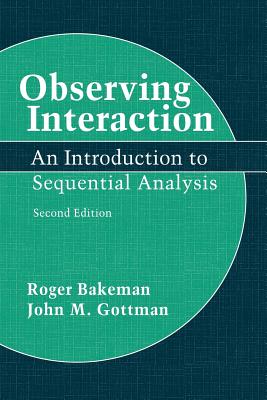Mothers and infants exchanging gleeful vocalizations, married couples discussing their problems, children playing, birds courting, and monkeys fighting all have this in common: their interactions unfold over time. Almost anyone who is interested can observe and describe such phenomena. However, scientists usually demand more than a desription--they want observations that are replicable and amenable to scientific analysis, while still faithful to the dynamics of the phenomena studied. This book provides a straightforward introduction to scientific methods for observing social behavior. The second edition clarifies and extends material from the first edition, especially with respect to data analysis. A common standard for sequential data is introduced and sequential analysis is placed on firmer, log-linear statistical footing. The second edition is designed to work as a companion volume to Analyzing Interaction (1995). Because of the importance of time in the dynamics of social interaction, sequential approaches to analyzing and understanding social behavior are emphasized. An advanced knowledge of statistical analysis is not required. Instead, the authors present fundamental concepts and offer practical advice.
| FindBook |
有 1 項符合
Observing Interaction: An Introduction to Sequential Analysis的圖書 |
 |
Observing Interaction: An Introduction to Sequential Analysis 作者:Bakeman、Roger/Gottman、John Mordecha 出版社:Cambridge University Press 出版日期:1997-03-13 語言:英文 規格:平裝 / 224頁 / 23.1 x 15.2 x 1.5 cm / 普通級 / 再版 |
| 圖書館借閱 |
| 國家圖書館 | 全國圖書書目資訊網 | 國立公共資訊圖書館 | 電子書服務平台 | MetaCat 跨館整合查詢 |
| 臺北市立圖書館 | 新北市立圖書館 | 基隆市公共圖書館 | 桃園市立圖書館 | 新竹縣公共圖書館 |
| 苗栗縣立圖書館 | 臺中市立圖書館 | 彰化縣公共圖書館 | 南投縣文化局 | 雲林縣公共圖書館 |
| 嘉義縣圖書館 | 臺南市立圖書館 | 高雄市立圖書館 | 屏東縣公共圖書館 | 宜蘭縣公共圖書館 |
| 花蓮縣文化局 | 臺東縣文化處 |
|
|
圖書介紹 - 資料來源:博客來 評分:
圖書名稱:Observing Interaction: An Introduction to Sequential Analysis
Total Black Empowerment Through the Creation of Powerful Minds
Why Ferenczi?
Justice-Involved Youth: Healing Through Trauma with Creativity and Community Regeneration + Peer-Support Workbook
Justice-Involved Youth: Healing Through Trauma with Creativity and Community Regeneration + Peer-Support Workbook
Talking the Talk: Language, Psychology and Science
Talking the Talk: Language, Psychology and Science
The Psychology of Advertising
Psychological Assessment of Adult Posttraumatic States: Phenomenology, Diagnosis, and Measurement
Digital Addictions: An Interdisciplinary Approach to Behavioral Addictions and Digital Media
The Twentysomething Treatment: A Revolutionary Remedy for an Uncertain Age
Why Ferenczi?
Justice-Involved Youth: Healing Through Trauma with Creativity and Community Regeneration + Peer-Support Workbook
Justice-Involved Youth: Healing Through Trauma with Creativity and Community Regeneration + Peer-Support Workbook
Talking the Talk: Language, Psychology and Science
Talking the Talk: Language, Psychology and Science
The Psychology of Advertising
Psychological Assessment of Adult Posttraumatic States: Phenomenology, Diagnosis, and Measurement
Digital Addictions: An Interdisciplinary Approach to Behavioral Addictions and Digital Media
The Twentysomething Treatment: A Revolutionary Remedy for an Uncertain Age
|









